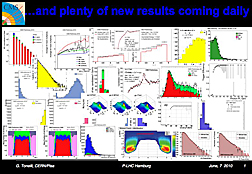- Number 314 |
- June 21, 2010
First LHC results
Some of the results shown by the CMS
collaboration at the Physics at LHC
conference. (Click image for larger version.)
Earlier this month, 270 particle physicists gathered at the “Physics at LHC” conference at DESY, the particle physics laboratory in Hamburg, Germany. The spokespeople of all four major LHC experiments—ALICE, ATLAS, CMS, and LHCb—showed their first results and reported that their detectors work exceptionally well. Both the ATLAS and CMS collaborations, for example, have had at least a 90-percent uptime for recording data.
So far, the number of collisions produced is still too small to find hints of new particles and forces. But after collecting high-energy collision data for little more than two months, scientists already have rediscovered many of the building blocks of the theoretical framework known as the Standard Model of particles and forces. By collecting the data of millions of proton-proton collisions per second, the LHC detectors have identified bottom quarks, W bosons and many other known particles. The measurements beautifully match those made by previous experiments and will be important for validating future results when the LHC ventures into new, unexplored territory.
Results obtained at the Tevatron collider at DOE’s Fermi National Accelerator Laboratory indicate that the discovery of the Higgs boson at the LHC will require more collision data than the LHC experiments expect to collect in the next year or so. But the higher collision energy of the LHC—3.5 times higher than the Tevatron—could provide scientists access to other undiscovered phenomena within the next couple of years and reveal the first signatures of new particles, new symmetries or even extra dimensions of space.
Thousands of physicists from around the world are working feverishly to analyze the bounty of LHC data. Scientists from institutions in the United States, funded by the Department of Energy and the National Science Foundation, account for about one third of all people working on the LHC experiments.
Submitted by DOE's Fermi National Accelerator Laboratory

